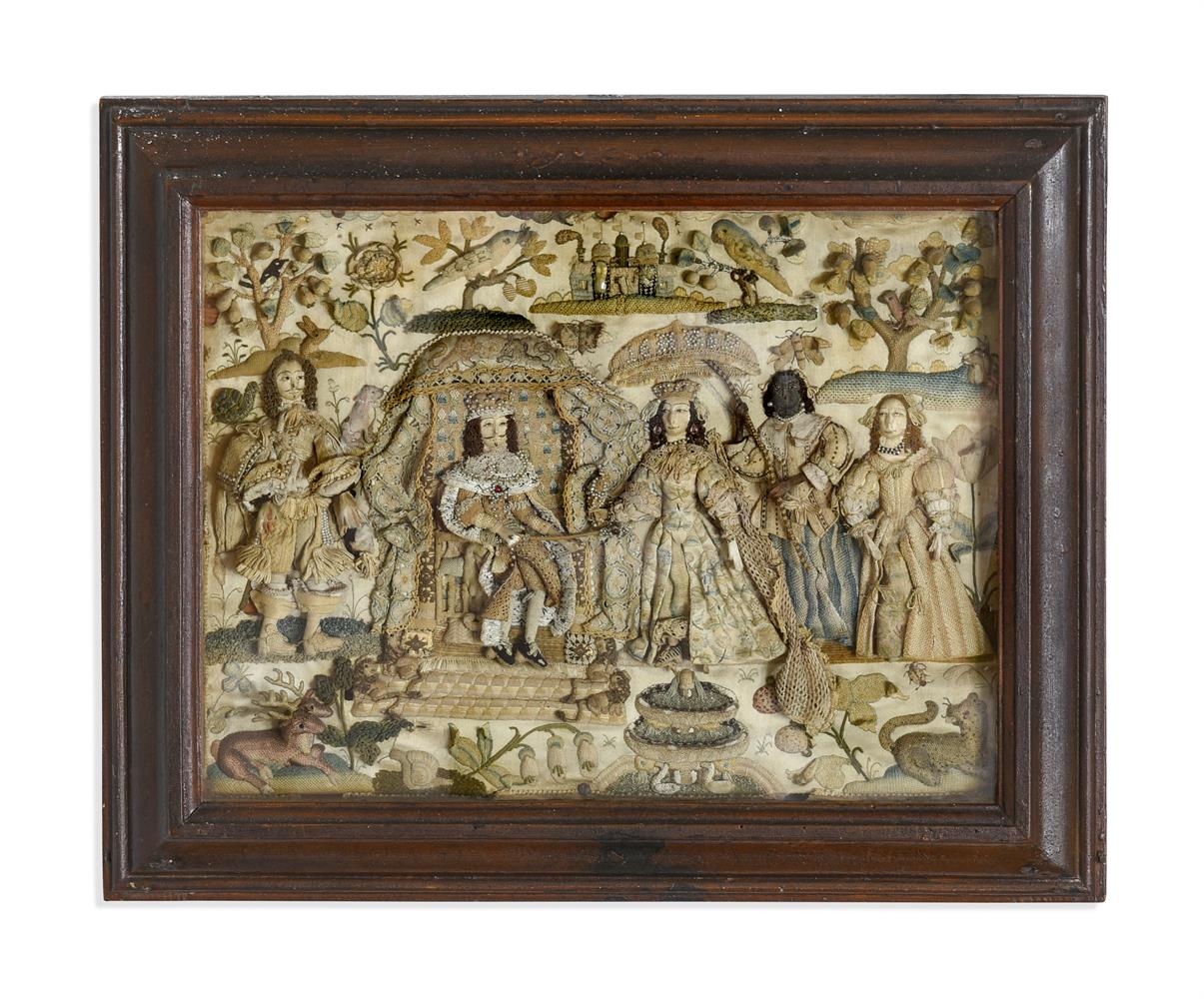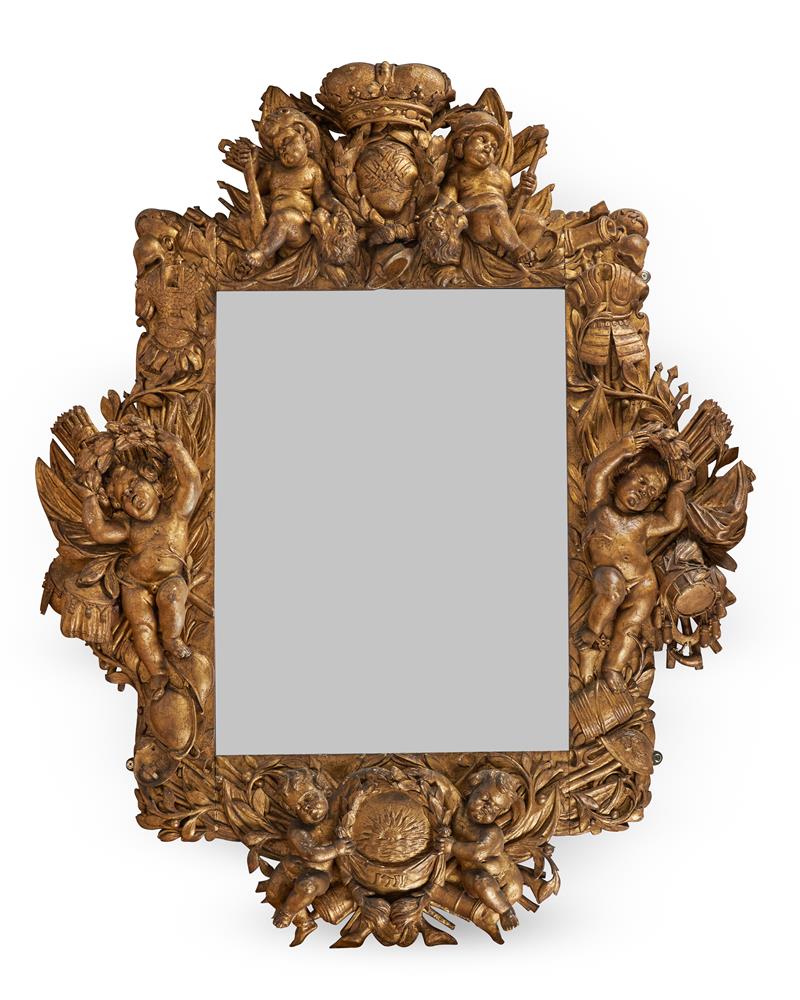A rare Charles II brass lantern clock Edward Webb Chew Stoke, dated November 7th, circa 1680 The posted countwheel bell-striking movement now with anchor escapement for regulation by short bob pendulum swinging outside the frame to the rear, the dial with central alarm disc within stylised symmetrical foliate engraved infill incorporating a winged female mask at twelve o'clock and with pierced black painted brass hand within applied narrow Roman numeral chapter ring with stylised fleur-de-lys hour markers and engraved with date nove -7 to the dial plate behind the V numeral, the upper angles engraved with signature Edward Webb , the typical 'Chew Valley' frame with one-piece column turned corner posts beneath lion and unicorn armorial engraved and pierced frets, integral multi-knopped tall vase-and-cover turned finials and domed bell bearer cast with pierced leaf decoration between the limbs, with brass side doors and iron backplate between hanging hoop above spurs to rear, on tall disc-knopped ball feet, (mostly retrained using original pivot plates/bars, alarm lacking), 40cm (15.75ins) high. Edward Webb is recorded in Moore, A. J. THE CLOCKMAKERS OF SOMERSET 1650-1900 as married to Anne with sons Walter (1667), James (1670), Richard (1674), George (1678) and William (?). He was probably the son of Charles Webb who owned a foundry in Chew Stoke. Both Edward and his wife Anne died in 1694. Nine lantern clocks by Edward Webb dated 1676, 1678, 1681, 1684, 1688, 1691, 1692, 1692 and 1693 are recorded with the 1684 and 1688 clocks fully described an illustrated in White, George English Lantern Clocks on pages 232 (Figures V/39 and 40), 233 (V/42 detailing date March 10 engraved beneath the chapter ring of the 1684 clock) and 237 (V/51 and 52). In addition to these Moore notes a further undated lantern clock signed Edward Webb of Chewstoke fecit , and a posted musical longcase clock movement and dial (also illustrated by White on page 233, Figure V/43). From these references it would appear that the present clock is currently an unrecorded example of Webb s work. The current lot utilises frame castings that were favoured by the Bristol and Chew Valley school of clockmakers with the earliest surviving being the Edward Webb 1676 example (private collection). All the other recorded lantern clocks by Webb (dates ranging from 1678-93) all share the same frame castings. These castings were also used by John London of Bristol, Thomas Veale of Chew Magna and latterly by Edward Bilbie of Chew Stoke (who is believed to have succeeded Edward Webb in around 1695). Bilbie appears to have persisted with the use of such castings long after Bristol makers had moved onto patterns more closely related to London work of the period, suggesting that such frames were probably cast locally (in the Chew Valley) - perhaps initially by Edward Webb at his foundry in Chew Stoke then by the Bilbie family after Webb's death in 1694. Another noteworthy detail is the distinctive dial engraving which is executed with scrolling foliage issuing from a central point at the base of the dial centre, continuing symmetrically around the alarm disc and terminating with a central winged female mask motif at the top. The design of this decoration is typical of Webb and appears to have its roots in the work of Thomas Brown of Bristol who was most active during the 1650's (see White, George English Lantern Clocks page 232) and can be directly compared to a clock by John Clarke of Bristol which was sold in these rooms on 15th September 2015 (lot 185) for £9,500 hammer.
A rare Charles II brass lantern clock Edward Webb Chew Stoke, dated November 7th, circa 1680 The posted countwheel bell-striking movement now with anchor escapement for regulation by short bob pendulum swinging outside the frame to the rear, the dial with central alarm disc within stylised symmetrical foliate engraved infill incorporating a winged female mask at twelve o'clock and with pierced black painted brass hand within applied narrow Roman numeral chapter ring with stylised fleur-de-lys hour markers and engraved with date nove -7 to the dial plate behind the V numeral, the upper angles engraved with signature Edward Webb , the typical 'Chew Valley' frame with one-piece column turned corner posts beneath lion and unicorn armorial engraved and pierced frets, integral multi-knopped tall vase-and-cover turned finials and domed bell bearer cast with pierced leaf decoration between the limbs, with brass side doors and iron backplate between hanging hoop above spurs to rear, on tall disc-knopped ball feet, (mostly retrained using original pivot plates/bars, alarm lacking), 40cm (15.75ins) high. Edward Webb is recorded in Moore, A. J. THE CLOCKMAKERS OF SOMERSET 1650-1900 as married to Anne with sons Walter (1667), James (1670), Richard (1674), George (1678) and William (?). He was probably the son of Charles Webb who owned a foundry in Chew Stoke. Both Edward and his wife Anne died in 1694. Nine lantern clocks by Edward Webb dated 1676, 1678, 1681, 1684, 1688, 1691, 1692, 1692 and 1693 are recorded with the 1684 and 1688 clocks fully described an illustrated in White, George English Lantern Clocks on pages 232 (Figures V/39 and 40), 233 (V/42 detailing date March 10 engraved beneath the chapter ring of the 1684 clock) and 237 (V/51 and 52). In addition to these Moore notes a further undated lantern clock signed Edward Webb of Chewstoke fecit , and a posted musical longcase clock movement and dial (also illustrated by White on page 233, Figure V/43). From these references it would appear that the present clock is currently an unrecorded example of Webb s work. The current lot utilises frame castings that were favoured by the Bristol and Chew Valley school of clockmakers with the earliest surviving being the Edward Webb 1676 example (private collection). All the other recorded lantern clocks by Webb (dates ranging from 1678-93) all share the same frame castings. These castings were also used by John London of Bristol, Thomas Veale of Chew Magna and latterly by Edward Bilbie of Chew Stoke (who is believed to have succeeded Edward Webb in around 1695). Bilbie appears to have persisted with the use of such castings long after Bristol makers had moved onto patterns more closely related to London work of the period, suggesting that such frames were probably cast locally (in the Chew Valley) - perhaps initially by Edward Webb at his foundry in Chew Stoke then by the Bilbie family after Webb's death in 1694. Another noteworthy detail is the distinctive dial engraving which is executed with scrolling foliage issuing from a central point at the base of the dial centre, continuing symmetrically around the alarm disc and terminating with a central winged female mask motif at the top. The design of this decoration is typical of Webb and appears to have its roots in the work of Thomas Brown of Bristol who was most active during the 1650's (see White, George English Lantern Clocks page 232) and can be directly compared to a clock by John Clarke of Bristol which was sold in these rooms on 15th September 2015 (lot 185) for £9,500 hammer.















Testen Sie LotSearch und seine Premium-Features 7 Tage - ohne Kosten!
Lassen Sie sich automatisch über neue Objekte in kommenden Auktionen benachrichtigen.
Suchauftrag anlegen